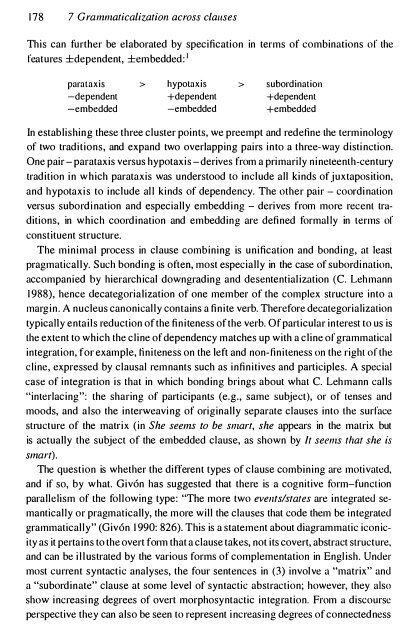Gram - SEAS
Gram - SEAS
Gram - SEAS
Create successful ePaper yourself
Turn your PDF publications into a flip-book with our unique Google optimized e-Paper software.
178 7 <strong>Gram</strong>maticalization across clauses<br />
This can fu rther be elaborated by specification in terms of combinations of the<br />
features ±dependent, ±embedded: I<br />
parataxis<br />
-dependent<br />
-embedded<br />
> hypotaxis<br />
+dependent<br />
-embedded<br />
> subordination<br />
+dependent<br />
+embedded<br />
In establishing these three cluster points, we preempt and redefine the terminology<br />
of two traditions, and expand two overlapping pairs into a three-way distinction.<br />
One pair-parataxis versus hypotaxis -derives from a primarily nineteenth-century<br />
tradition in which parataxis was understood to include all kinds of juxtaposition,<br />
and hypotaxis to include all kinds of dependency. The other pair - coordination<br />
versus subordination and especially embedding - derives from more recent traditions,<br />
in which coordination and embedding are defined formally in terms of<br />
constituent structure.<br />
The minimal process in clause combining is unification and bonding, at least<br />
pragmatically. Such bonding is often, most especially in the case of subordination,<br />
accompanied by hierarchical downgrading and desententialization (c. Lehmann<br />
1988), hence decategorialization of one member of the complex structure into a<br />
margin. A nucleus canonically contains a finite verb. Therefore decategorialization<br />
typically entails reduction of the finiteness of the verb. OfparLicular interest to us is<br />
the extent to which the cline of dependency matches up with a cline of grammatical<br />
integration, for example, finiteness on the left and non-finiteness on the right of the<br />
cline, expressed by clausal remnants such as infinitives and participles. A special<br />
case of integration is that in which bonding brings about what C. Lehmann calls<br />
"interlacing": the sharing of participants (e.g., same subject), or of tenses and<br />
moods, and also the interweaving of originally separate clauses into the surface<br />
structure of the matrix (in She seems to be smart, she appears in the matrix but<br />
is actually the subject of the embedded clause, as shown by It seems that she is<br />
smart).<br />
The question is whether the ditl'erent types of clause combining are motivated,<br />
and if so, by what. Giv6n has suggested that there is a cognitive form-function<br />
parallelism of the fo llowing type: "The more two events/states are integrated semantically<br />
or pragmatically, the more will the clauses that code them be integrated<br />
grammatically" (Giv6n 1990: 826). This is a statement about diagrammatic iconicity<br />
as it pertains to the overt form that a clause takes, not its covert, abstract structure,<br />
and can be illustrated by the various forms of complementation in English. Under<br />
most current syntactic analyses, the four sentences in (3) involve a "matrix" and<br />
a "subordinate" clause at some level of syntactic abstraction; however, they also<br />
show increasing degrees of overt morphosyntactic integration. From a discourse<br />
perspective they can also be seen to represent increasing degrees of connectedness
















